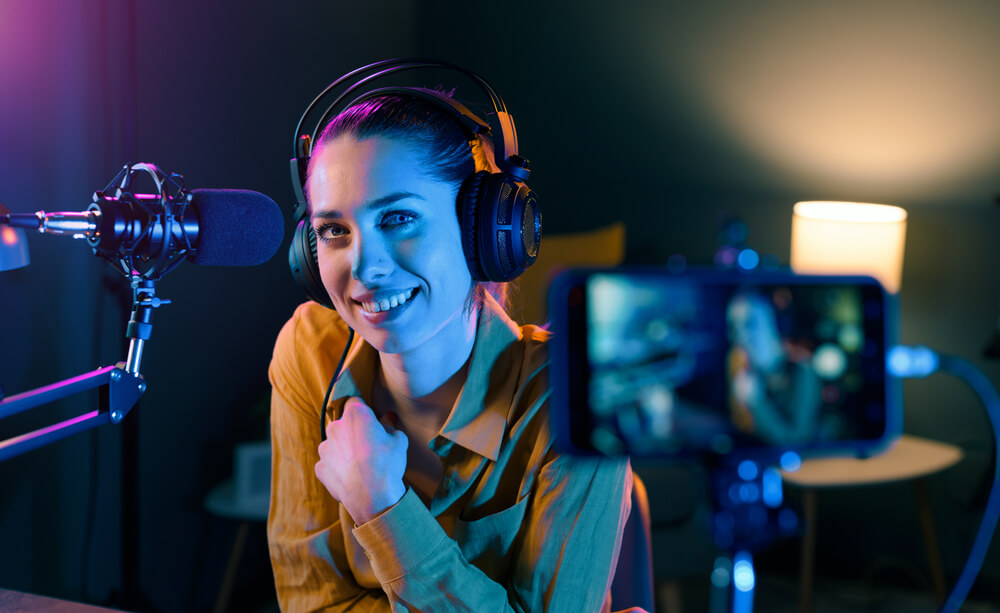This article originally appeared in Episodes, our newsletter. If you'd like insights on workflow and craft (like these) in your inbox every two weeks, you can subscribe here.
Even with all the production firepower of the Times of London behind him, James Shield can’t always count on capturing clean, clear audio for Stories of Our Times, the daily podcast he produces.
The Times has correspondents all over the world, and when they appear on the show James often has to settle for imperfect recording conditions. They’re reporters, not audio producers, and they might be holed up in a hotel room somewhere, talking into their laptop mic, or out on the street, recording an interview on an iPhone.
Audio like that isn’t so bad for a 15-second news hit on live radio. But in a half-hour podcast it would drive listeners crazy.
James’s job is to fix it. One of the ways he does that is by applying Studio Sound — Descript's regenerative-speech technology — to remove noise and enhance speakers’ voices.
Normally in this newsletter we try to avoid talking too much about Descript. But Studio Sound is such a game changer, we’re making an exception. Not to try to sell you on using it, but to offer some thinking on how it can make your life easier as a creator, and on how to get the most out of a pretty remarkable tool.
Studio Sound’s primary value is in post-production – the way James uses it on his podcast. If something goes wrong when you record – your guest doesn’t have a good mic, or your neighbor is out there with his damn leaf blower – you can fix it in one click. It’s beautiful.
But Studio Sound can help expedite your workflow on the front end too. When you’re setting up to record, when you’re recording, even when you’re scheduling a recording – Studio Sound can grease the skids on all of those things, and reduce your stress every step of the way.
Science! How Studio Sound works
To understand how to get the most out of Studio Sound it helps to understand a little bit about how the AI works works, but not too much – we’ll keep it at the liberal-arts level.
To build Studio Sound, Descript research scientists taught a computer model to identify the sounds that conflict with speech in the human ear. That’s reverb, echo, hissing noises, and so on. Then they found a way to simulate the creation of those sounds – i.e., the degradation of audio. And then they reversed the process, so the model could learn to break audio down, remove distracting sounds and regenerate speaking voices.
Aside from just being kind of cool, in practical terms this means Studio Sound knows how to identify and remove problematic audio. As a general rule, the worse the audio, the more Studio Sound can do for you. We’d also note that, while AI can be scary, Studio Sound has shown no interest in subjugating the human race, so far.
Guests: anywhere, anytime
Chances are you’re not producing a daily news podcast, or interviewing far-flung correspondents, like James Shield. But you might be doing a podcast where you talk to guests, and if so Studio Sound can be incredibly liberating.
No longer do you need to stress about where your guest will be when you interview them, what kind of gear they’ll be recording with, or how they’ll sound on Zoom or any platform. You’ll be able to clean it up with Studio Sound.
That should make it much easier to schedule guests as well — instead of battling to find a time when they’re available and can be in a quiet room with minimal echo and reverb, you can offer to do the interview while they’re driving, waiting for a train, walking down the street. Anytime, anywhere.
Once they’re scheduled, you can also excuse yourself from stressing over their recording setup. It probably still makes sense to send them a one-pager on the ideal recording conditions, but if they never read it, or they read it but ignore it, or they just don’t have the gear, or can’t get to the right place, you’ll be fine.
Set yourself free
All of the above goes for recording yourself too, whether you’re making an interview show or something else. If you’re producing your show in Descript, you can record just about anywhere – on a walk, in a coffee shop, wherever – and know that Studio Sound will clean it up for you.
We’re not saying you should record your podcast on the sidewalk, just that you should take advantage of the flexibility Studio Sound gives you. It’s hard enough to find time to create something, so anything that makes it easier will lower your blood pressure and free you up to give more time and attention to the thing you really care about: your content.
Lastly, we’ll note that if you’re just getting started as a creator, Studio Sound gives you the option of not investing in an expensive mic or retrofitting your guest room as a recording studio. Just use what you have and start tinkering with Studio Sound.
Of course, we wouldn’t ever tell you not to use a good mic, or to ignore your recording conditions. Both of those things are incredibly important. But Studio Sound gives you a reliable safety net, so when something goes wrong on the front end it won't wreck everything that comes after..
Getting the most out of Studio Sound
Finally, a few tips on getting the most out of Studio Sound. For the most part, it’s super simple. Upload your audio, toggle it on and let the AI do its work.
But there is some craft here. If you’ve used Studio Sound before you know it can sometimes leave voices sounding slightly over-processed. You can mitigate that by modulating Studio Sound’s intensity. When you toggle it on, Descript applies Studio Sound at full power – 100%. That’s where speakers may sound a little unnatural.
Try dialing the intensity down, say by 10%. Then keep reducing it until you find the sweet spot with your most natural-sounding voice and the least background noise. James, from The Times of London, says he usually lands somewhere in the 40-50% range.
Adding EQ also helps. In regenerating your voice Studio sounds sometimes leaves you sounding a little muddy, with more bass than you have in real life; adding a high-shelf EQ boost can help smooth that out.
Since we launched Studio Sound in July, creators have used it to enhance 42,500 hours of audio. That’s almost five years’ worth, or roughly 2,000 seasons of Hard Core History . As we said at the top, it’s a powerful tool that has implications all up and down your workflow.






































%20(1).JPG)

